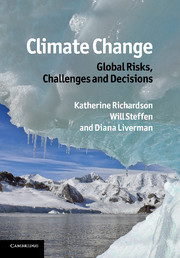Book contents
- Frontmatter
- Contents
- Writing team
- Foreword
- Preface
- List of acronyms and abbreviations
- Part I Climatic trends
- Part II Defining ‘dangerous climate change’
- Part III Equity issues
- 9 The equity challenge and climate policy: responsibilities, vulnerabilities and inequality in the response to climate change
- 10 A long-term perspective on climate change: values and ethics
- Part IV Mitigation and adaptation approaches
- Part V Meeting the challenge
- Index
- Plate section
- References
9 - The equity challenge and climate policy: responsibilities, vulnerabilities and inequality in the response to climate change
Published online by Cambridge University Press: 04 April 2011
- Frontmatter
- Contents
- Writing team
- Foreword
- Preface
- List of acronyms and abbreviations
- Part I Climatic trends
- Part II Defining ‘dangerous climate change’
- Part III Equity issues
- 9 The equity challenge and climate policy: responsibilities, vulnerabilities and inequality in the response to climate change
- 10 A long-term perspective on climate change: values and ethics
- Part IV Mitigation and adaptation approaches
- Part V Meeting the challenge
- Index
- Plate section
- References
Summary
‘Our climate is owned by no one and yet needed by everyone, rich and poor. As we struggle to act together to save it, we stumble across one devastating idea. Our survival depends on equity.’
The discussions about responses to climate change are dominated by concerns about equity – between rich and poor, North and South, present and future generations, investment in mitigation and adaptation, and between humans and the rest of nature. These discussions contrast with the global biophysical nature of climate change, wherein greenhouse gases are well mixed globally and quickly lose any biophysical connection with the place where they were emitted and in which the complexities of the Earth System produce impacts in regions far from those that emit most of the greenhouse gases.
We are dealing with a tragedy of the global commons and with the enormous challenges of a collective action problem. As the Stern Review argues: ‘no two countries will face exactly the same situation in terms of impacts or the costs and benefits of action, and no country can take effective action to control the risks that they face alone. International collective action to tackle the problem is required because climate change is a global public good – countries can free-ride on each others' efforts – and because co-operative action will greatly reduce the costs of both mitigation and adaptation. The international collective response to the climate change problem required is therefore unique, both in terms of its complexity and depth’ (Stern, 2007).
- Type
- Chapter
- Information
- Climate Change: Global Risks, Challenges and Decisions , pp. 229 - 259Publisher: Cambridge University PressPrint publication year: 2011

